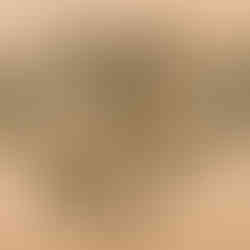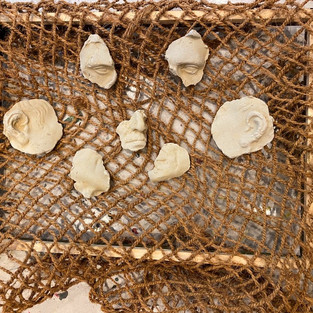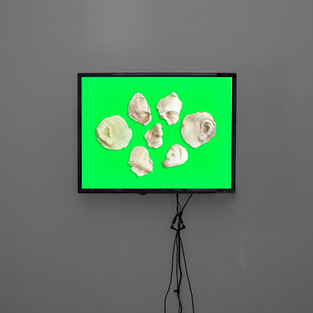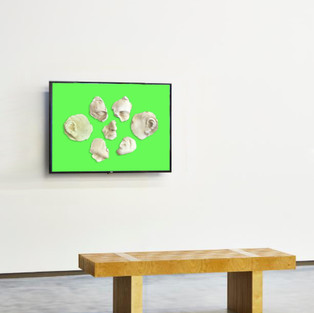Project 7 Bas-relief Work 3
- Marina WitteMann
- Sep 30, 2020
- 7 min read
Updated: Jan 15, 2021

7 plaster pieces, average 14L x 12W x 4H cm. presented on the screen
I wanted to make the third work more dynamic and experimental. In doing so, I focused on the work process, as my tutor recommended.

Since creating a relief in its nature is a copy of objects, why not try this with volumetric things? Transfer a three-dimensional object to the flatness. Instead of placing the model in clay, I applied the clay on the model. Next, I covered with plaster the resulting surface.


After art school, I have a sculpture of Caesar. I copied it many times as a drawing during art lessons in Moscow.

I thought it was very rhetorical to start copying Caesar again but using new possibilities. There are no restrictions from the Russian school - I can do what I want, and not only copy with an old and boring classical approach.
When the pieces were dry, I was amazed at the responsiveness of the material. Eyes, nose, hair, cheekbones have been copied, with great precision.

New individual parts of the face looked like a puzzle that needs to be assembled, to restore the complete picture. It reminds me of a Gestalt. That is, our brain will strive to combine what we have seen into an understandable whole. So, such an arrangement of Caesar's face might prompt discussion and trigger the thought process.
In order to find a solution to the presentation of this relief, I began to move parts; supplement them with different elements; search of the place.
Another key thing to mention, at this moment, I was asking myself if I left the process of making or not? Main work with the material is finished. While gypsum is drying, I’m just assembling objects around me. But where are the borders of working with the material? If I take a photo of this original sculpture pieces and continue to adapt it in PhotoShop, would it be the same sculpting process or something new?
To give an illustration, Artist Matthew Stone photographs paint strokes, processes them in a computer, shapes the work and prints it on canvas. Thus, the artist revised painting process. He also adapted it to the technical capabilities of our time. I thought it would be interesting to do the same with the relief.

I what to remind, that I copied only the front of sculpture since for representing an essential part of the Caesar this would be enough. Next, I photographed the resulting pieces and transferred them to PhotoShop.

The most crucial moment for me was that, on the one hand, probably no one will ever see this relief in the natural world, except me. On the other hand, this relief will be seen many times, through the screens of phones and computers.

To put it another way, I printed the work on paper and cut seven pieces out. They were flat and one-sided. It is how the viewer sees it on the screen.

But how then to present this artwork?
Having a natural object is no longer needed. The tutor and the commission at the University will only evaluate photographs and videos of my work. These seven pieces will always be flat in the eyes of viewers. The volume of the relief will remain only in the photo of the details themselves.
Should it be printed photography on the wall?
Or it can be photography displayed on the screen?
How the viewer will see it? What does a person see in fact? What do I want the viewer to see?
The viewer sees a broken sculpture with the features of a man.
Does he look like Putin on this photo?

For comparison, Sir Eduardo Paolozzi deliberately sawed his copy of Michelangelo’s ‘David’, and after that mix it with wooden blocks. Without taking into account the political intentions of the artist, such an interpretation may prompt us to rethink the famous sculpture. Divide and put back together. How does work look like now, which has been copied innumerable times? (Here is similar to my drawings of Caeser) It became different. We recognize the features of David, but he is different. He is not preparing for a fight, but he already seems to be beaten.

Sir Eduardo Paolozzi, Michelangelo’s ‘David’, 1987, Plaster, plywood and string, Object: 310 × 240 × 210 mm, 7.2 kg COLLECTION TateSculpture] At: https://www.tate.org.uk/art/artworks/paolozzi-michelangelos-david-t06944(Accessed 14.01.2021)
It is interesting how our representation of art objects is changing. For example, Sir Eduardo Palozzi later returns to the sculpture of David again and adapts the eyes, nose and mouth for a large Newton sculpture in front of the British Library.

Statue: British Library - Newton, Eduardo Paolozzi, 1995 Bronze, 12 foot high [Sculpture] At: https://www.londonremembers.com/memorials/british-library-newton (Accessed 14.01.2021)
And what is happening now? In 2005, Sotheby's sells these separate items as a stand-alone piece of art. And it was sold for 1,560 GBP (Sothebys, Online. At: https://www.sothebys.com/fr/auctions/ecatalogue/lot.230.html/2005/20th-century-british-and-irish-art-w05715 (Accessed 14.01.2021)
I wonder how this work was presented in real life as a result, but this representation (photo) is available on the Internet.

Sir Eduardo Paolozzi, 1924-2005 EYES, NOSE AND MOUTH AFTER MICHELANGELO'S DAVID four plaster largest 20.5cm. [Sculpture] At: https://www.sothebys.com/fr/auctions/ecatalogue/lot.230.html/2005/20th-century-british-and-irish-art-w05715 (Accessed 14.01.2021)
It turns out that the selling company (Sotheby's) adapted the artist's working materials and formed a new art object with a purpose in mind to make a profit. Thereby appeared a new visual identity without the artist.

My Caesar pieces were not sawed or cut. In the beginning, they were as separate pieces. The edges of the plaster pieces rounded. Initially, they did not belong to each other. But together they become one image. Therefore, I cannot apply here the method of rethinking the sculpture as in Paolozzi, Michelangelo's 'David', 1987. Rather, man can ask the question, why was it necessary to make a copy of the sculpture in parts? Because the copying of the sculpture takes place in parts. Front and backside or intricate part and so on. Or, probably, the more details you copy, the more exact the whole. Or, it is a trigger for gestalt - viewer needs to resolve it.
This method allowed me to flatten the sculpture. And I think it is all about it. If I would copy the whole sculpture in one or two pieces (front and back) then it would be three-dimensional. Yet, in this case, I can make volumetric or I can live it flat. Here flatness is what I’m about.
Furthermore, I was searching for the background for the photo. The green colour would channel thought into special effects possibilities and refer to the digital world. It's like a background for special effects where an editor decides what will be on the background.

Cinemablend. Support Visual Effects Protests With Revealing Green-Screen Photography [Photography] At: https://www.cinemablend.com/new/Support-Visual-Effects-Protests-With-Revealing-Green-Screen-Photography-36006.html (Accessed 14.01.2021)

Dailysportx Ese Mind-Boggling Green Screen Pictures Reveal How Animation Works In Films [Photography] At: https://www.dailysportx.com/worldwide/green-screen/47 (Accessed 14.01.2021)
With the development of this technologies cinema became a wonderland. And only one real entity left in this surrealistic world is a man.

Petra Cortright: ‘Of course it’s feminist’. Photograph: Supplied [Video art] At: https://www.theguardian.com/artanddesign/2015/jul/22/petra-cortright-post-internet-art-los-angeles-exhibit (Accessed 14.01.2021)
Art scene did not miss such an innovation. For instance, Petra Cortright brings digital into a physical world. She creates her mixture of inspirations and prints it or represent as a video. Artist uses all kinds of features and bugs for recreating the effects of the digital space. In the work presented above, this green background potentially can be everything – forest, underwater… But it is what it is. New background – green space.
Candice Breitz also used a green background for the work “Love Story”.
Love Story (2016), a seven-channel installation by Candice Breitz, interrogates the mechanics of identification and the conditions under which empathy is produced. The work is based on the personal narratives of six individuals who have fled their countries in response to a range of oppressive conditions... ... The personal accounts shared by the interviewees are articulated twice by Love Story. In the first space of the installation, re-performed fragments from the six interviews are woven into a fast-paced montage featuring Hollywood actors Alec Baldwin and Julianne Moore (who are cast in the work as themselves: ‘an actor’ and ‘an actress’). (Candice Breitz, Love Story [online] At: https://www.candicebreitz.net/ (Accessed 14.01.2021)

Candice Breitz, Love Story. Alec Baldwin And Julianne Moore Share Refugee Stories In South Africa [Video art] At: https://theartgorgeous.com/alec-baldwin-julianne-moore-share-refugee-stories-south-africa/ (Accessed 14.01.2021)
The artist used a green background to create a nod to Hollywood blockbusters. In which in her opinion, people tend to believe more than to real people or even refugees.

If I transfer these conclusions to my work? Usually, a person is the only thing that is alive (real) against a green background of special effects, then in my case, the sculptural pieces of a portrait are something that is natural. In fact, the portrait of Caesar is presented flat, but due to the green background, there is a hint that we can actually do anything with this real sculpture. It can become voluminous.
Thus, I believe the best way to present this work is on the screen:

Considering all of the above, the work discusses the real and the digital, the plane and volume and where are the boundaries of these concepts.
In order to be correlated with the task of the project, I'm reasoning here about what can be called relief?
It can be also called a digital plaster relief because we see volume in photographs of a man's face, but at the same time, these details are on the plane. But the fact remains, the viewer looks through the flat screen.
If to refer to the meaning of the relief “the building up of parts of a surface to form a picture or design that can be seen above the background, or a work of art made by this method” (Cambridge Dictionary, Online At: https://dictionary.cambridge.org/dictionary/english/relief (Accessed 01.10.2020)
Does it bring us to the idea that here in front of us actually, two reliefs one digital with Caesar and one is with the TV as a relief?
Bibliography and references
1. “Being Reliant, Not Being Reliant, Being Not Reliant” (2016), Digital print and acrylic on linen, 71 x 47 inches At: https://www.thisiscolossal.com/2018/09/digital-paintings-by-matthew-stone/ (Accessed 01.10.2020)
2. Plaster sculpture: Guy Julius Caesar Гипсовая скульптура: Гай Юлий Цезарь [Sculpture] At: https://images.app.goo.gl/tF3cr13qEqYpefDc7(Accessed 01.10.2020)


































Comments